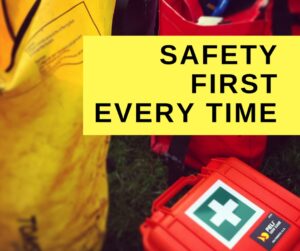Here’s the thing…. the temptation to squeeze in money paying work in is great, but sometimes there are more valuable and important things that can be done. None more so than the regular practice of Aerial Rescue techniques.
In case you aren’t aware – tree surgery is inherently dangerous, at best our Arborists are working with sharp handsaws and ropes, at worst it’s chainsaws! Pieces of wood weighing in excess of 250kg can be cut and lowered to the ground, or swung around (in a controlled manner). You don’t need to be a genius to realise the risks involved and the potential for very nasty outcomes. On a fairy regular basis Arborists are injured up trees, sometimes, in very tragic cases these injuries can be fatal. A young tree surgeon bled out in a tree in Clapham, London last year leaving a wife and two children. It’s the stuff of nightmares.
We need to do all we can to reduce these accidents happening in the first place, this is essentially an eduction process. We have ethos of safety first at About Trees, this seems to have installed good working practice amongst the team. Risk Assessments, whilst somewhat tedious are an invaluable tool to start conversations with regarding the site, the hazards and measures to be put in place. However, accidents do happen, how can we be sure we are well placed to deal with them?
Quick question…. who’s the best person to rescue an Arborist in trouble up a tree? Firefighter? Paramedic? Police? Coastguard? Spiderman?
The answer……
Another Arborist!
Yes that’s right, your colleagues on the ground, second climber, grounds person are the people who are going to save your life. They have to be competent, and calm in such a situation. They have to weigh up the scenario, act appropriately and SAVE a life. After all by the time the emergency services have found you on site it could be too late!
How can you be sure that all of these abilities will fall into place if the unimaginable happens?
PRACTICE PRACTICE PRACTICE

Joe “rescuing” Nathan
When & Where?
So when we (About Trees) have a spare half day the urge to squeeze another little job in is resisted – instead, it’s Aerial Rescue techniques time. We find a large tree and essentially have a little play around with different scenarios. It may seem a little OTT but this is important and can save lives. Regular drills are imperative and increase the chance of a favourable outcome if the worst should ever occur. It’s about being confident.
Whenever we climb large trees we always install a rescue line up the tree so a rescuer can get to the victim quick sharp – it sets everyone’s mind at ease. Part of the risk assessment contains postcode/grid reference for emergency services, a mobile is kept with the team on the ground. These are all parts of the Aerial rescue tools we use.
A rescue plan is spoken over prior to all tree climbing commencing. A rescue kit, compromising of a full climbing kit and spikes (climbing irons) is laid out ready to go if needed as close to the tree as possible. Trauma first aid kits with Haemostats (blood clotting) products are always nearby. All of these measures, we hope add to a sense of being well looked after. The idea is to reduce stress on everyone. After all, if you feel as if you are being looked after, you feel safer.

Helping hand
Rescuers should be equipped with Emergency First aid training, they will have to use the techniques learned in the classroom on their colleague at height, regularly Arborists are working 25metres+ above ground level. So many companies will put their climbers at huge risk by not having a competent climber on the ground who can act as a rescuer. One word – IRRESPONSIBLE! We are talking about lives being at risk here.
No body within the industry will argue that aerial rescue techniques are not important to our industry. We are trained in Aerial rescue techniques at college before being allowed to climb trees using chainsaws, it’s the bare minimum a tree surgeon needs. So many of us get the ticket and then never re-visit of refresh our knowledge.
So it begs the question…
If it’s so important why are they so seldom practiced regularly?
As an industry we have access to the trees (clearly), the equipment (obviously) the people (um yeah). I can only draw one conclusion in answering the question. To me it all seems down to money! I understand, we are all in business to earn money, but this cannot be at any cost. Once a month, for less than half a day. I’d wager that a huge proportion of tree companies do not practice Aerial Rescue on an annual basis.
We need to view this practice as “golden”.

Paul & Nathan making their way back to ground.
So, fellow “Arbs” resist that urge to earn a few quid more. Half a day once a month……. it could be the best half days work you’ve ever missed out on!

One last word
PRACTICE PRACTICE PRACTICE
OK that was 3

